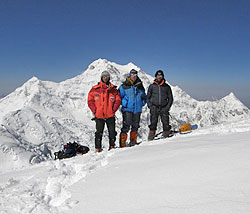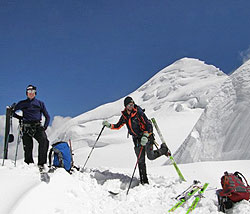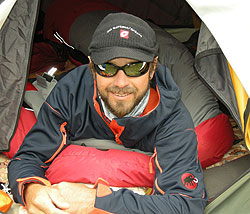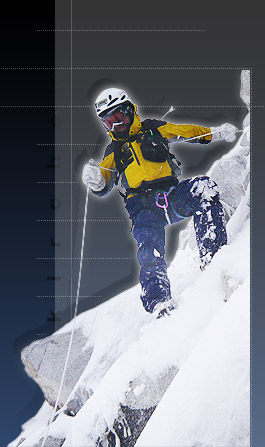 |
Nanga Parabat Expedition
| |
| 4th Statement - Base Camp, 5 th July 2008 |
 |
On the third of July at 9.20am we are at the top of the principal peak of the Chongra at 8630 meters.
Who knows if anybody else has ever been on that peak. I immagine so but surely nobody has climbed via the west crest that we took. I ask Marteen who asks the locals but nobody knows. We chose this route to help our acclimatization. |
| |
On the first of July we set off from base camp, firstly descending 200 meters to access the Rakhiot glacier. We have very heavy backpacks packed with the tent, our sleeping bags, the gas stove, a few days food and all the necessary rock and ice climbing equipment. This time we're not carrying ski as they would be unnecessary weight and we wouldn't be able to use them for the climb anyway. The glacier doesn't cause any difficulty and we reach the opposite side in no time. From there, as before, we follow a ridge which is part rock and 500 meters above we reach a plateau. We continue along a ridge which seamed a logical route but little did we know what state the rock was in. High up the climb becomes vertical and we split in order to find the best route up, the rock is friable making it exceptionally dangerous. After 10 hours climb with heavy backpacks and the thin air on top of that, every step is a huge effort. Finally we make it to the top of this particularly dangerous stretch and access one of the many ice flows that come off the glacier off the west side of the Chongra. It is late afternoon and we feel the full heat of the sun on our heads, there is a light breeze that we are now used to. The snow on the glacier is slushy and each step sinks in, soon we reach a plateau at 5700 meters where we decide to set up camp, it's been a long hard day. The next day we face the west spur of our mountain, we set off early but unfortunately the sun catches up with us quickly. After climbing two steep ramps with the most slushy snow and the heat of the sun suffocating us we decide to stop, it seams to have taken us hours to cover a few meters distance. We set up the tent at 6400 meters, it's incredibly hot and today the usual light breeze has deserted us. We eat some nuts and raisins and take some much needed rest. The night comes, we have the privilege of viewing another spectacular scene, with a cloudless sky the stars seem to be millions. We wake up early the next day, but I'm not feeling well, I feel nauseous and my stomach is churning, of course the altitude is to blame. It's freezing and by sunrise we are ready to leave. The surface of the ice is solid to start so we make good ground but before long we start to sink up to our calves and not long after up to the hip. It is hard to understand how the snow stays put on such a steepslope and even harder to believe how long it takes us to cover such a short distance in this soft snow. After four and a half hours we make it to the peak, the Chongra has been conquered, it's ours! The view is breathtaking. To the north, starting from the giant Rakaposhi, we can see all the other famous and not so famous giants. Clearly recognisable are the 7000 Batura, the Lathok Towers and even the Karakorum giants .- K2, Brosd Peak and Gasherbrum. We can't stay up on the peak for long as it's getting hotter and hotter and we have a 3000 meter descent to do. We decide to a traverse the south crest. The descent isn't too taxing but we have no liquids left and exhaustion is beginning to kick in. By evening we make it back to base camp.
|
|
| |
| |
| 3rd Statement - Base Camp, 28th June 2008 |
 |
Our hunger is insatiable, we eat four times a day and drink continuously. Even though our choice of food stuffs is limited we try to vary our diet as much as possible to stop ourselves feeling sick. I feel to have lost weight and my biceps seem to have turned to jelly.
We have returned to base camp after having set up a second camp at a higher level to help our acclimatization. I can confirm that my crisis point (that is the altitude where I start to feel weak, nauseous and find that every movement requires a huge effort to the point of wondering if I will ever be able to make it to the peak?!) is between 4000 and 5000 meters. |
| |
The weather is still good with just occasional afternoon storms which freshen up the air nicely. It would suit us to have some bad weather now which would give us more chance of better weather later on when we get to the peak. On our rest days we start to feel restless and our desire to start the full climb grows, particularly at sun set when we see ourselves surrounded by an amphitheatre of ice and the peak of the Nanga Barbato which turns to a stunning gold. The weather is bright and sunny, so much so that the heat effects the ice of the Rakhiot pillar negatively. I wonder why the pillar is called Rakhiot when the locals call it RAIKHOT!? At night I sleep in my sleeping bag on a mattress covered with a rug I bought in Islamabad. Nights can be restless, I wake up as I feel the wind lift, and think....... “We are here and have a mission.....that wall, that ice pillar..... I can't get it out of my head”. The night plays games with my mind making me jump from one thought to the next: The pillar will take 10 – 12 hours to climb, the chances of it crashing down whilst we are on it can't be high..... or can they?! You never know......We were born one day and will all die one day.... in the middle there is life.... a mystery that nobody has the key to.... we are in Gods hands.... if he calls us we have to go, our time is up. I am aware that public opinion does not agree with us facing such climbs as these and taking such risks, what if we really don't make it, what if that pillar comes crashing down on us, so many would say: “What was the point, why do it? One thing is certain, those who don't live the mountain cannot know. The mountain calls!!
The following morning we get up early, at 5 o'clock Olam our cook is already up and is preparing “chapati” (something similar looking to pizza made with integral flour, salt and water which is cooked on a hot dry plate). Today we are traveling light and reach our second camp in less than five hours, it is situated on protruding rock at 5200 meters, which we are sure is safe from any ice falls from above, the only risk could be lightning..... it wouldn't be the first time. We sleep there for the night and wake again early the next day. Our sleep was often interrupted by the sound of ice pillars breaking away, something that is not new to us as of course the glacier is constantly moving at an astonishing pace. This time we take the tents down to continue to a higher point carrying them on our backs. We are each carrying about 20 kg. First we abseil for about 60 meters to set foot on the glacier, from where the climb looks O.K. The snow conditions on the ice seem excellent and we continue carrying out skis. We overcome the most insidious glacial step which takes us to the plateau which divides Nanga Parabat from the peaks of the Chongra. The sun has been with us now for a few hours and it is incredibly hot. Finally we locate a suitable place to set up camp again. We are at about 5900 meters sitting under a dormant ice pillar, we should be out of danger of avalanches. The tents are set up as quickly as possible as we can see a storm coming. The climate is crazy here, it changes from almost tropical heat to freezing cold. In our tents we warm ourselves sitting around the flame from a gas bottle and drink a mug of tea. By evening the storm has passed and the sky clears. We view the sunset from the most incredible and unforgettable position, the sun is horizontal to our tent and reflects off the clouds and snow creating a stunning carousel of flaming colours. Dinner is made up of some parmesan and speck brought from home with bread, we are all hungry which is a good sign!
At sunrise we slide out of our sleeping bags, drink some warm tea and set off towards our destination, the South Chongra (6448 m). A bit further up we put our alpine skis on and make our way up the glacier, the ice is smooth and the peak is getting closer. The final part steepens and we climb up towards the sky on foot. Just before 10 we make it! Looking north east through the clouds we can just make out K2. We study our descent from Nanga Parbat, down the famous silver strip named by our German colleagues. Hurray.... it looks possible to ski down and we make it back to our tents by noon. We decide to continue back to base camp even if the heat of the sun has softened the surface a lot, with skis we hope it will be better. We fix our tents well and leave them there as we will need them again when we return to the Nanga Parbat. We ski quickly down making our way through the ices insidious crevice and soon reach the headland of rock. Here we stop to admire “our pillar” on the Raikhot wall and decide to make our way down a different route so we can study her better. Just as we are getting closer, a piece of ice breaks away and causes an avalanche, it doesn't look much to start but soon it picks up more snow and momentum. I tell Walter to film as we race down to base camp. It is simply unbelievable to watch this avalanche which exploded at 7500 meters, it is slowly making its way towards base camp getting bigger and bigger, we realize it's going to hit us and start to get a bit nervous but I don't want to miss it. Once before I have been inside that white mass and been covered with a fine layer of the millions of particles of snow and ice which in seconds cover you. It reminds me of the Pianura Padana in Northern Italy, when in winter you can be lost in the fog and all of a sudden it disappears as if nothing had ever happened. By evening we make it back to base camp again and will rest up ready for the next attack!!
|
|
| |
| |
| 2nd Statement - Base Camp, 18th June 2008 |
 |
THE DIARY OF Karl Unterkircher, Walter Nones and Simon Kehrer´s from Base Camp.
Today there are also several films linked to YouTube.
We have been at base camp for several days now, it is positioned between two tongues of ice at about 4000 meters. The camp was fairly easy to get to and it only took two days. The first day we used a jeep to travel along some pretty exposed and dangerous roads until we reached a village called Jail. From there we continued on foot until we reached the most enchanting place, above the glacial deposit, between a dense forest of pine trees, so beautiful that it is known by the locals as Fairy Meadows. We can see our mountain straight ahead of us with 3000 meters of ice pillars. All three of us feel overwhelmed by its majestic beauty, it makes us feel almost afraid and full of respect. |
| |
We spend the night in a small house and dine in a spacious hall with photos of many famous climbers including Merkl and Buhl all around the walls. The next day after a few hours walk we reach Base Camp, a field covered with thousands and thousands of wild flowers and lots of fat friendly marmots. Our senses are overwhelmed with the beauty combined with the many different smells of flowers and the birds singing. It really is a stunning place!
This is a historic base camp where half a century ago many german expeditions were organized. There is nobody here, we are absolutely alone…… this says it all; nobody else wants to attempt the climb from this side! Undoubtedly this is an ambitious project. There is a monstrous central wall which has to be the starting place for this climb. We believe it must be possible but realize that it will take time to acclimatize before attempting it. In the following days there are small off loads of snow and ice…. it´s very hot. After a few days we decide to climb via the glacier taking the Hermann Buhl route to set another camp at 5200 meters on a spur of rock.
We want to check out where we plan to decend. We´re carrying heavy backpacks and there is still lots of snow on the glacier, it’s a good job we have skis as this facilitates the climb and makes the decent a lot easier.
|
|
| |
|
 |
|
